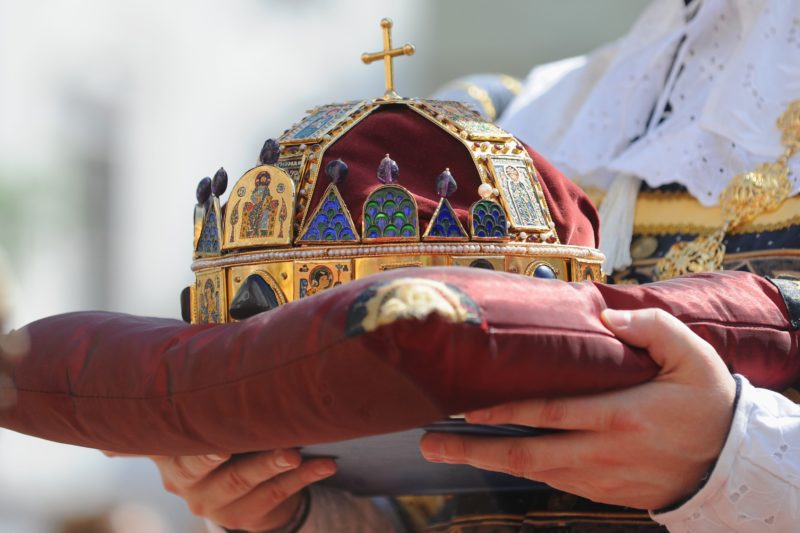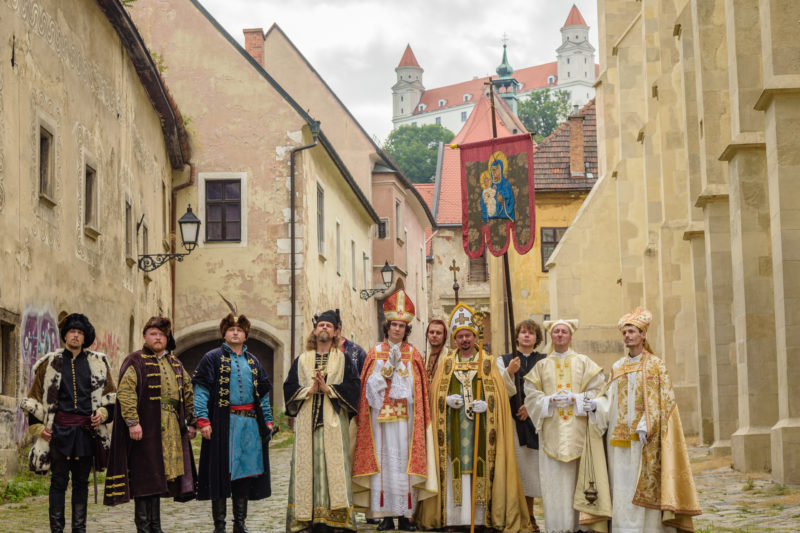Coronation Celebrations in Bratislava
Whenever a new king was crowned, the exact course of the ceremony would be approved by the Coronation Council, which also determined the precise route to be taken to incorporate different celebrations. The future monarch would always enter the city by the same gate and follow the footsteps of his predecessors.
Before the coronation, the new ruler would cross over the Danube to the city on a bridge that stood on boats or pontoons, where he would be welcomed with fanfare and honor. He would stay either at the Castle or in the Archbishop’s residence in the city, where Primate’s Square is today.

Coronation Ceremony
The coronation itself took place at St. Martin’s Cathedral, where the future monarch would ride from the Castle or the Archbishop’s palace on either a horse or in a coach. He would enter the sanctuary from the southern entrance and, after having been crowned king, would leave the House of Coronation by the north gate. In the solemnly decorated cathedral, the king would be welcomed by the clergy and world dignitaries. Loges would be set up for those watching the coronation ceremony, which lasted several hours, and stairs to the stage would be set up right in the cathedral. The coronation ceremony took place during a Pontifical High Mass. The Holy Crown of Hungary, also known as the Crown of St. Stephen, would be placed on the head of the new king by the Archbishop of Esztergom, the highest dignitary in the region representing the Pope.
A scepter would be put in the king’s right hand and a golden orb in his left. Then in the presence of the Palatine, they would cry three times “Vivat Rex! – Long live the King! This would be followed by the singing of the hymn Te Deum and the Mass would continue. When a queen consort was crowned, the Royal Crown of Hungary would be held above the queen’s right shoulder to symbolize her willingness to stand beside her husband and to help carry the burden of royal duties. The queen consort would not be crowned by the Archbishop of Esztergom, but instead by the Archbishop of Veszprém. At the ceremony a crown produced for the Habsburgs would be used for this purpose instead of the Crown of St. Stephen and no sword, scepter or royal orb would be given.

Coronation Procession
Leaving the cathedral, the newly elected king would be escorted through the city along a special coronation route. The priests would walk at the head of the procession with a cross in front, while behind them would be the magnates carrying flags of the lands belonging to Hungary. The coronation route from the cathedral to the Franciscan monastery would be covered by either a red carpet or one in the red-white-green tricolors of Hungary, which would be torn into pieces after the procession by the city’s residents. En route to the Franciscan Church, the coronation escort would pass across the square in front of the Town Hall and walk along the fountain with the statue of Maximilian, the first King of Hungary to have been crowned in Pressburg. Maria Theresa was the only monarch to stop during her coronation procession at the marble column standing in front of the Jesuit Church with a statue of the Virgin Mary, in order to bow before her patroness.

The Fitting of Knights
At the Franciscan church, there was a canopied podium on which a throne stood for the king. It was here where the king would receive the coronation sword from men chosen to be the Knights of the Golden Spur for their faithful service to the Monarchy. The Knights could afterward wear gold or gold-plated spurs, carry golden sabers and their horses could have golden trappings. After the ceremony, the procession with the king riding a horse (Maria Theresa rode in a coach) would pass along the narrow Weisse Gasse (now Biela ulica) lined with buildings whose facades were pure white.

Solemn Oath
They would then leave the medieval town through Michael’s Gate and across a stone bridge over the moat to stop at an open area outside the city walls, where a wooden stage had been set up covered with red or tri-color drapery. It was on this stage that yet another important event celebrating the coronation took place, where the new ruler would take a solemn oath. The king would repeat aloud the oath to the Archbishop of Esztergom. He would then commit himself to preserving rights and privileges, the integrity of the land and to eventually acquire new territory or free the parts of the kingdom that were currently under occupation. After taking the oath, the new king would be greeted with shouts of joy from the people present. The Palatine would again cry out three times “Vivat Rex!” and the crowd would repeat it. The place was long called Schwurplatz (Square of the Oath or Námestie Prísahy in Slovak), but now it is the site of SNP Square. It was here at the end of the 17th century that a monastery for the Brothers of Mercy was built with a church and a hospital.

Coronation Hill
The final event in the coronation ceremony would take place along the bank of the Danube River (at today’s Ľudovít Štúr Square), where the procession would ride on horses along the city walls. Before the celebration, soil from all of the counties in the Kingdom of Hungary was brought here to create a coronation hill. The king would come on horseback to the hill, waving a sword in the four cardinal directions to promise symbolically protection for his kingdom against enemies from all corners of the world. After the ceremony there would be fanfare, drums, gun salvos and cannons fired from the Castle.
For the newly-chosen king a coronation feast would be prepared either inside the castle or at the Primate’s Palace while people were also celebrating in the streets of the city. During the procession, money and commemorative coins would be thrown to the people, oxen were roasted on stakes and the fountains would be spraying wine. And the entertainment was never boring, as knights would joust in tournaments and there would be fireworks at night.

Coronation Insignia of the Kings of Hungary
Different objects symbolizing royal power were handed to the monarch during the coronation. In Hungary, the king would receive the Crown of St. Stephen and during the ceremony he would also be dressed in a richly embroidered coronet cloak, dubbed with a sword by the Knight’s of the Golden Spur and hold a golden orb with a two-barred cross at the top and a scepter whose gold-plated silver handle was adorned with a sphere made from mountain crystal and decorated with gold chains.
The crowning of a new monarch used to be preceded by a gathering of the Coronation Council, which elected the king. Later, the monarch’s successor would be directly designated by him and in 1687 the Coronation Council enshrined the Habsburgs’ right to the Hungarian crown and throne into law. The new king would always be the first-born son of the previous king. But during the reign of Charles III (VI) this law was expanded to allow daughters of the ruler to be crowned in the absence of any male issue.